


CLICK ON THE PHOTO TO ZOOM IN
sagalassos ancıent cıty
aglasun turkey
The archaeological site of Sagalassos is located in southwest Turkey over the mountains near the present town of Ağlasun of Burdur province. İt is about 100 km drive distance from the holiday city Antalya at the south coasts of Turkey. The ancient city was founded on the south facing slopes of the Taurus mountain range and was the metropolis of the Roman province of Pisidia in asia Minor. İt has both mountainous landscape, and a series of lakes form of the regional geography. Today this region is known as the ''District of Lakes''

It is thought that The first traces of settlements of hunter/gatherers in the territory where Sagalassos was, date back to some 12 000 years BP. During the eighth millennium BC, farmers settled along, the shores of Lake Burdur. During the Bronze Age, the area was ruled by territorial tribes. Sagalassos was most probably hadn't been yet occupied at those times. Around 14th century BC, Hittite inscriptions mention about the mountain site of Salawassa, which could be the former name of the settlement. When the area was under Phrygian and Lydian domination the site gradually developed and became an urban centre. During the Persian period, Pisidia region, where sagalassos beelonged became known for its courageous and rebellious factions; it has a reputation about the strong resistence and heroic act when Alexander the Great tried the conquer the region in 332 BC on the way of his conquering intention of Persian Kingdom
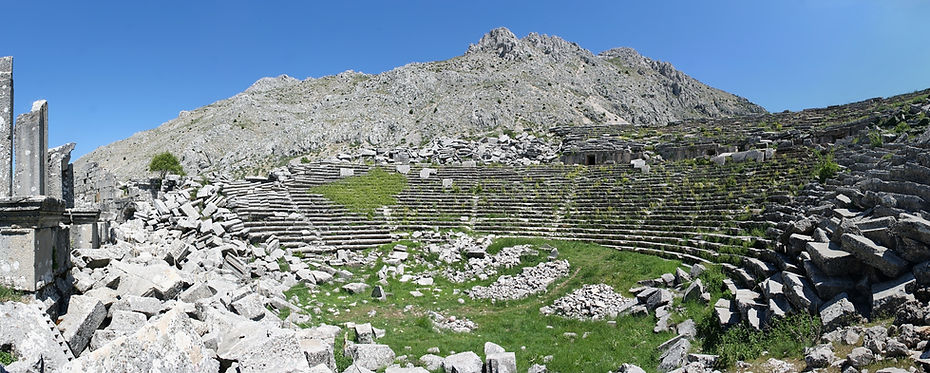
CLICK ON THE PHOTO TO ZOOM IN

CLICK ON THE PHOTO TO ZOOM IN
Pisidia changed hands many times among the successors of Alexander. İt was dominated by the kingdom Antigonos Monopthalmos between 321-301 BC. Possibly it reagained its autonomy under Lysimachos of Thrace ruled between 301-281 BC, and then conquered again by the Seleucids of Syria between 281-189 BC. Attalids of Pergamon domineted rhe region between the dates 189-133 BC. Municipal institutions and material culture of Greek origin point out to fairly quick Hellenisation when considering recent discoveries. After the Attalids bequeathed their kingdom to Rome, Pisidia at first became part of the newly created Roman province of Asia & for a short period coastal province of Cilicia.
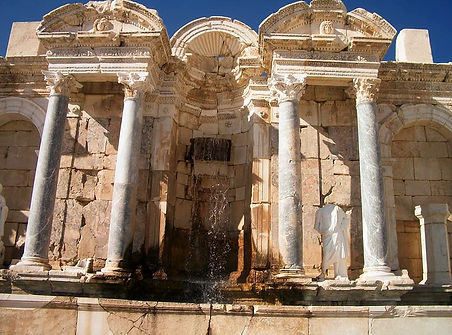
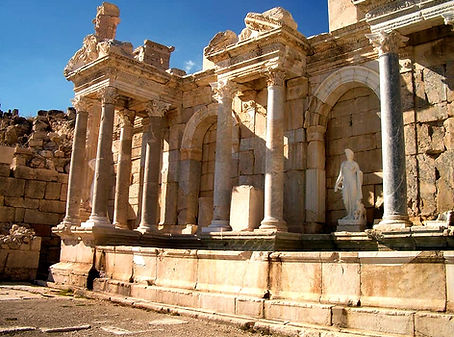
Sagalassos and its territory was accepted on that period as dependable and very prospering partners of Roman Empire. The region was enabling the empire to control an extremely fertile territory with a surplus production of grain and olives, as well as the presence of excellent clay beds allowing an industrial production of high quality table ware which was known as "Sagalassos red slip ware". These features made the export of local products possible. Rapidly, under Roman Imperial rule, Sagalassos became the metropolis of Pisidia. The first Roman emperor, Augustus, was probably the most influential character in the story of Sagalassos. Not that he was directly involved in the city, but under his reign there was peace, the investment climate was favourable, the tax system was reformed, a road connected Sagalassos to the sea, and the population grew strongly. The climate was also warmer and wetter, allowing olive cultivation 500 m higher up the intramontane valleys than today. The local elite immediately saw the opportunities offered by this new context, particularly in economic terms. Unlike the rest of Pisidia, Sagalassos drew the Roman card without renouncing its identity. The first century was indeed a golden age for Sagalassos. Trouble only started around 400 AD, when the town had to fortify its civic centre against, among others, rebellious Isaurian tribes. Sagalassos seems to have remained rather prosperous even under these conditions. After the earthquake around 500 AD, it was restored with a great sense of monumentality.

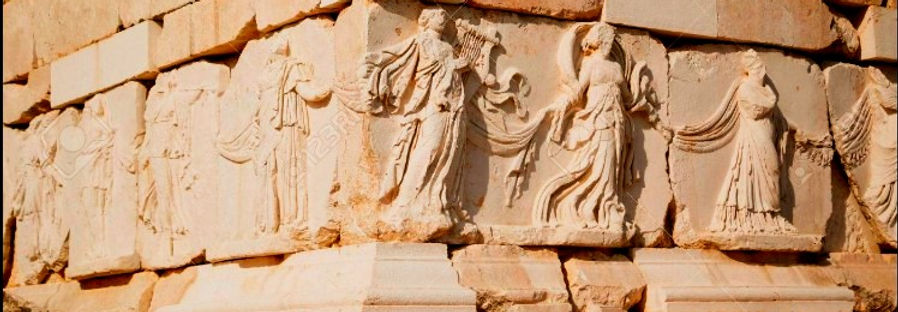
As a result of recurring epidemics after the middle of the 6th century and related general decline of the economic system in Asia Minor, the city started to lose population. Large parts of the town were abandoned and the urban life was replaced by a more rural way of living.
In the 7th century AD, the situation had further aggravated due to continuous Arab raids and new epidemics when the city was struck once more with a heavy earthquake, most probably around 590 AD. Despite this disaster, recent research has proven that the city remained occupied until the 13th century in the form of isolated and well-defended hamlets, located on some promontories which maintained the name of the former ancient city. One of these hamlets found on the Alexander's Hill of Sagalassos was destroyed in mid 13th century, by which time Seljuk's had already build a bath and a caravanserai in the village in the valley. The abandoned ancient city was then rapidly covered under vegetation and erosion layers. As a result of its remote location, Sagalassos was not really looted in later periods and remained to be one of the best preserved ancient cities in the Mediterranean.
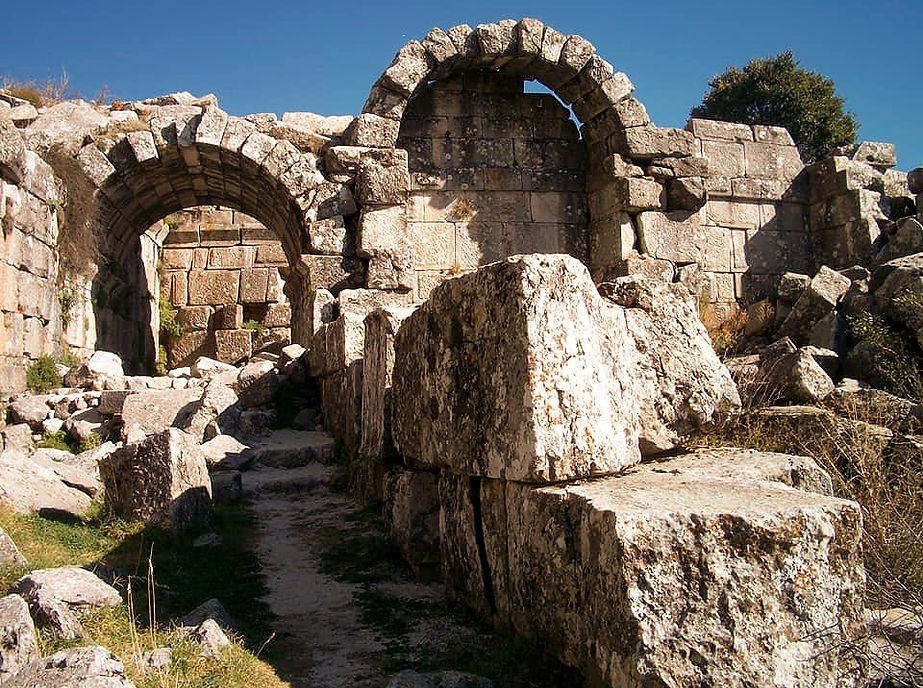
Why was the area chosen to be settled.
Despite the forbidding appearance of the site, there were good reasons to settle here. Security was one of them and the abundance of water was another. Sagalassos’ unique soil conditions – a water-permeable layer of limestone on top of a layer of clay – led to the formation of dozens of natural springs in the area of the city. The soils of the site also yielded clay for making high quality ceramics and bricks, and ores for metal production. In ancient times, the nearby valleys were also more fertile than today. In the heyday of the city, during the Roman Imperial period, it had another important advantage: Sagalassos was linked to the Anatolian road network and was thus connected with the interior, with the ports on the western coast of Ionia, and most importantly with those on the Mediterranean coast (ancient Pamphylia). All of these factors lured people to a prosperous city that enjoyed growing prestige and was open to innovation. Wheat, olives, probably also pine trees and high quality red-slip tableware formed the basis of the economy and were also exported.
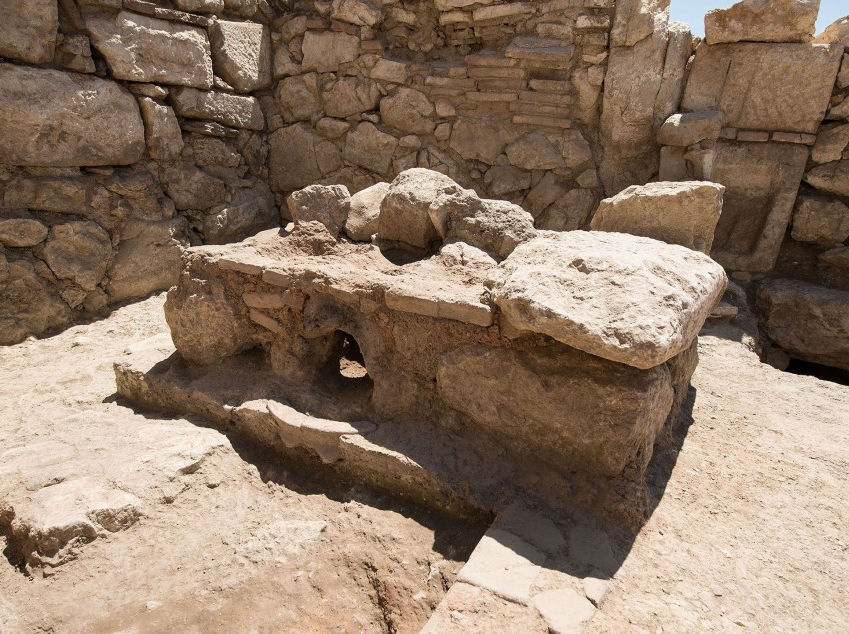
Important Structures
Alexander’s Hill Heavy with history
When Alexander the Great approached Sagalassos with his army in 333 BC, Sagalassians defended their city at ‘Alexander’s Hill’. At that time Sagalassos was already an important settlement in Pisidia. The conical hill has a flat top and steep flanks. Strategically important for its location and height, it controlled the southern approach to Sagalassos. Alexander defeated the Sagalassians in the battle and took their city, making it part of the Hellenistic world. There was probably never a settlement on the hill. In the Roman Imperial period, one of the four necropoleis (cemeteries) of Sagalassos developed along its slopes. This was one of the city’s largest and oldest necropoleis, covering 15.7 hectares. On top of the hill there was probably a pagan temple, replaced by a church in the 5th or the 6th century. Excavations showed that this church was renovated or decorated around 1000 AD. The latest remains on the hill date to just before 1200 AD, when a walled military garrison stood here. Possibly in 1204, this ‘fort’ seems to have been forcibly conquered. It was abandoned after this destruction.
The Temple of Hadrian and Antoninus Pius
Emperor Hadrian (117-138) declared Sagalassos the official centre of the Imperial Cult for the sub-province of Pisidia. This launched the city’s “golden age” and a period of intensive construction. Hadrian also gave Sagalassos the honorary title of ‘first city of Pisidia, friend and ally of the Romans’. A prestigious Imperial temple was built on a natural promontory to the south of the town, making it visible from afar. Construction began under Hadrian himself and was completed under his successor Antoninus Pius (138-161). When complete it was one of the most elaborate buildings in the city, with a courtyard more than 70 meters long and a porticoes surrounding the whole precinct. An inscription on the building proudly proclaimed Sagalassos’ new title for the first time. Every year, delegations from all the Pisidian cities came together here to honour the emperor with sacrifices, festivals, and processions along the Colonnaded Street. The temple was the centre of the imperial cult until the end of the 4th century AD. Its courtyard was filled with statues of and honorary monuments for emperors, priests, and victors of the festival games. From the end of the 4th century onwards, private construction started to appear on the temple grounds. This promontory, wellfortified from the mid-7th century, was one of the longest-inhabited places in Sagalassos. Settlement continued in this area until the 11th century when it moved from here down to Ağlasun.
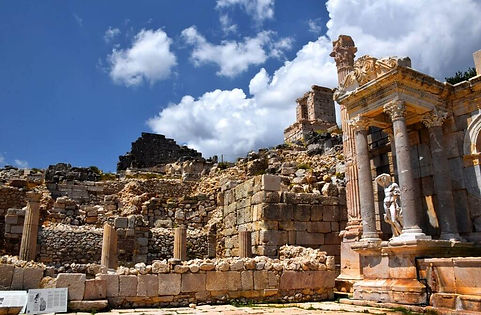
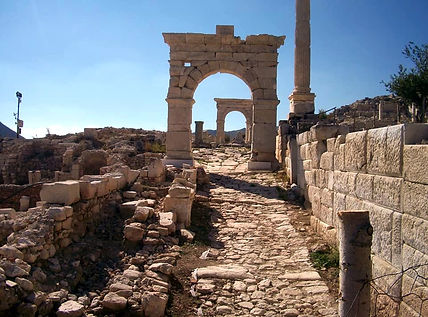
The Southern Gate and Towers Towers at a bottleneck
In the pre-Roman period, the southern entrance to Sagalassos was a gate flanked by two towers. The towers were later dismantled down to their foundations and rebuilt around the middle of the 7th century AD using material recycled from other buildings. This time a wall was constructed between them, blocking the paved street and providing no gate. One of these towers has been excavated. The wall was built at a bottleneck with towers facing north toward Sagalassos. It was intended to prevent attackers from the north, presumably Arab invaders, from reaching the terrace in the south. Although the sanctuary of the Imperial cult located there was no longer in use by the end of the 4th century, from the second half of the 5th century onwards the promontory was again occupied by local citizens.
The Colonnaded Street
The north-south Colonnaded Street of Sagalassos is an elegant paved avenue with porticos on both sides. Built during the second quarter of the 1st century AD, it is one of the earliest such streets in Asia Minor. The construction of the road must have been very expensive: to level the road, a deep depression between two hills had to be filled by hand with thousands of cubic meters of rock and soil. The Colonnaded Street was about 300 meters long and 10 meters wide. Along both sides of the street there were covered galleries (porticos) 3.5 meters wide. Rows of columns faced the street side, and behind them stood shops, eating houses and workshops. During the reign of Tiberius monumental gates were built at both ends of the street. A visitor approaching Sagalassos from the south would have taken the road around the foot of Alexander’s Hill and entered the city from the monumental gate at the southern end of the Colonnaded Street. The street was well-maintained until at least the 6th century AD.
The Macellum A market for luxury products
A market for luxury food products (macellum) was built on this terrace south of the Upper Agora in the last decade of the 2nd century AD, most likely replacing an Augustan predecessor built on the same spot. Later, decorative and utilitarian luxury products were also sold here, including jewellery, music instruments, and objects of worked bone, antler, metal, and glass. Servants of the wealthy came here to shop. The market was arranged around a courtyard of about 21 by 21 meters, and surrounded on three sides with shops behind expensive marble columns. The south side of the courtyard was an open colonnade offering impressive views towards the lower city and the valleys beyond.
The Arch of Claudius A monumental gate to the agora
Remains of a collapsed monumental arch visible in the topsoil in the southwest corner of the Upper Agora were first studied in 1987. It was identified as an arch dedicated to Emperor Caligula dating to 37-41 AD. Archaeologists excavated the area in 2010 and found that almost all of the building blocks were preserved as well as the two pillar bases of the arch. The building inscriptions revealed that the monument was financed by, “Kallikles, son of Darius”. He was a grandson of Eilagoas who was honoured with a bronze statue on top of the northwest column in the agora. This Sagalassian family was the first family in the city to acquire Roman citizenship, perhaps because they sponsored the construction of this arch. The building was indeed originally dedicated to Caligula. However upon his death, his name was condemned and erased from inscriptions all over the Empire including this arch in Sagalassos. Subsequently the arch was re-dedicated in 43 AD to his successor Emperor Claudius and his brother Germanicus, Caligula’s father. The original central inscription was erased and replaced by new ones at the two ends of the frieze.
Inscriptions were placed on the side of the arch facing the agora, while a weapon frieze decorated the side facing the southwest street approaching the agora. Although a popular theme for many centuries, this was the last weapon frieze on a public monument at Sagalassos. Statues of Claudius and Germanicus must have stood on top of the arch, but no remains of either the statues or the pedestals were recovered. The monument was restored using its original building stones in 2011-2013. An almost identical monumental arch, dedicated by the city to Claudius in 46 AD, stood just opposite to this one at the southeast corner of the Upper Agora.
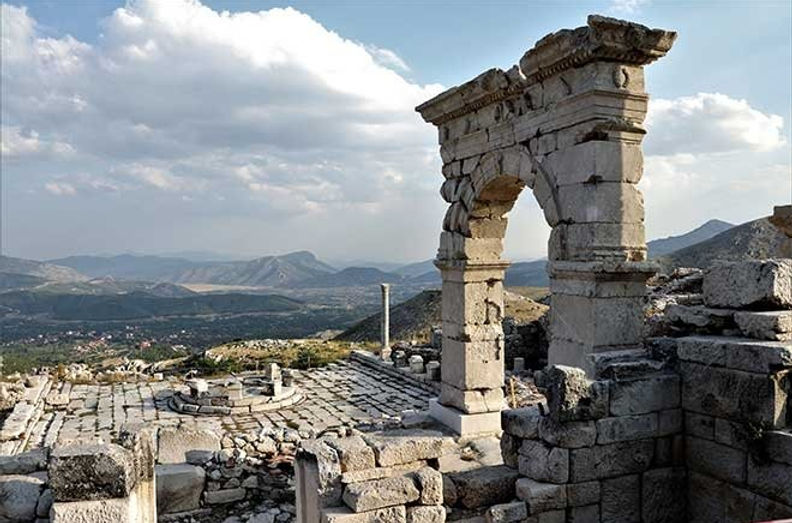
The Bouleuterion A building for the elected council
The city council building (bouleuterion), was built soon after 100 AD on a natural terrace to the west of the Upper Agora, flanked by a courtyard. This building is evidence that Sagalassos had an elected and active city council (boulé) at that time. The institution was already old by then: from the 4th century BC onwards Sagalassos was a polis (citystate) based on the Greek model, with elected magistrates and written laws. This model continued during the Roman period, although civic institutions were dominated by a few elite families, replacing democracy with oligarchy. The Bouleuterion had a strong symbolic meaning for Sagalassians. It was a reference point for many later buildings and monuments of the upper town, which followed its alignment. The rectangular limestone building itself was rather sober. It could seat 220 elected members. A frieze on the outside of the monument depicts weaponry and busts of the war gods Ares and Athena, which suggested Sagalassos’ military prowess. Corinthian style half capitals were used inside the building, a new and fashionable style in Pisidia at that time. From 200 AD onwards the Bouleuterion was no longer used and the city council probably met in the Odeon instead.
The Antonine Nymphaeum An opulent fountain
This fountain was constructed on the north side of the Upper Agora between 160 and 180 AD. It was exceptionally rich in decoration, with a dozen different types of stone used in its construction. It replaced a rather simple Doric fountain of the Augustan period, built against a terrace wall. This single-storey fountain is 28 metres long and almost nine metres high. Six ‘tabernacles’ project from the façade. The lateral ones (with two pairs of columns) project more than the central ones (with one pair of columns). The basin holds 81 cubic metres and was reached by a short staircase. Between 1998 and 2010 the fountain was reconstructed and its water system reconnected; this is the third monument restored at Sagalassos. During excavations, many statues were discovered inside the basin; in 2011, casts of these were restored to their locations in the nymphaeum. Sagalassos’ greatest benefactor, Titus. The fountain itself was repaired after 500 AD and was turned into a memorial monument for the Neon family. Some names of family members can be read in the inscriptions on the bases of the statues that were placed inside and even on top of the fountain.
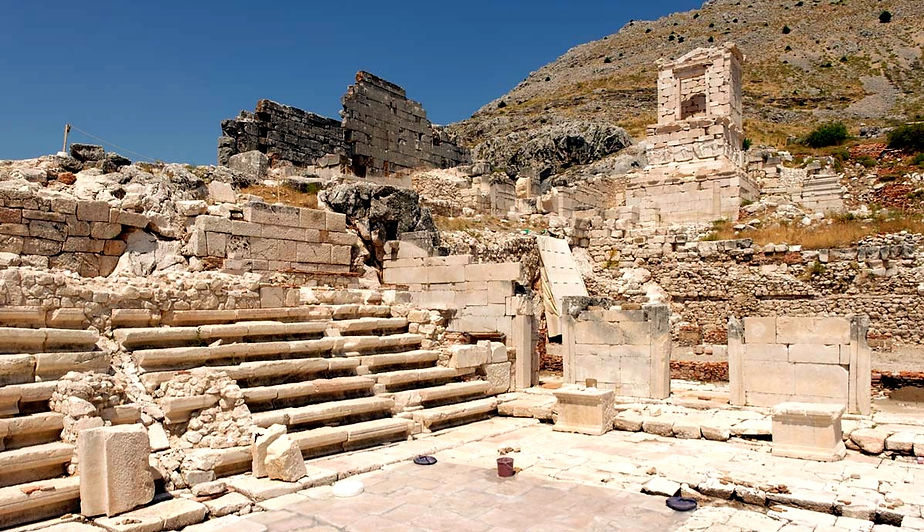
The Archangel Michael Basilica
Around 400 AD the old city council building (bouleuterion) of Sagalassos was abandoned, and its stones were re-used to build the new city walls. The place where the building once stood was turned into an open courtyard. The open space in front of the former council building was then used to build a Christian basilica, the first church in Sagalassos. It was likely devoted to the archangel Michael, who was widely venerated in Pisidia at that time. At first, the entrance to the church was from the south, but after the early 6th century a monumental staircase was built that connected the church directly to the Upper Agora. This new basilica was not used for very long. Shortly after 500 AD it was seriously damaged (probably by an earthquake). Its restoration was probably interrupted by the plague of 541-542 AD and never completed. It later collapsed after a major earthquake shortly after 600 AD. By that time, there were several other churches in Sagalassos.
The Antonine Nymphaeum An opulent fountain
This fountain was constructed on the north side of the Upper Agora between 160 and 180 AD. It was exceptionally rich in decoration, with a dozen different types of stone used in its construction. It replaced a rather simple Doric fountain of the Augustan period, built against a terrace wall. This single-storey fountain is 28 metres long and almost nine metres high. Six ‘tabernacles’ project from the façade. The lateral ones (with two pairs of columns) project more than the central ones (with one pair of columns). The basin holds 81 cubic metres and was reached by a short staircase. Between 1998 and 2010 the fountain was reconstructed and its water system reconnected; this is the third monument restored at Sagalassos. During excavations, many statues were discovered inside the basin; in 2011, casts of these were restored to their locations in the nymphaeum. Sagalassos’ greatest benefactor, Titus. The fountain itself was repaired after 500 AD and was turned into a memorial monument for the Neon family. Some names of family members can be read in the inscriptions on the bases of the statues that were placed inside and even on top of the fountain.





